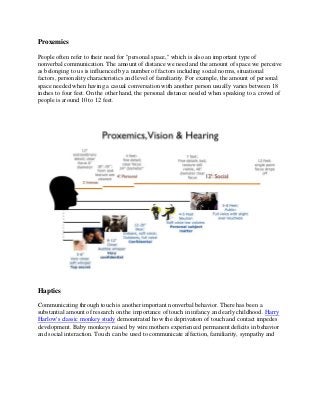
Proxemics groups is very imp for us and know a days
- 1. Proxemics People often refer to their need for "personal space," which is also an important type of nonverbal communication. The amount of distance we need and the amount of space we perceive as belonging to us is influenced by a number of factors including social norms, situational factors, personality characteristics and level of familiarity. For example, the amount of personal space needed when having a casual conversation with another person usually varies between 18 inches to four feet. On the other hand, the personal distance needed when speaking to a crowd of people is around 10 to 12 feet. Haptics Communicating through touch is another important nonverbal behavior. There has been a substantial amount of research on the importance of touch in infancy and early childhood. Harry Harlow's classic monkey study demonstrated how the deprivation of touch and contact impedes development. Baby monkeys raised by wire mothers experienced permanent deficits in behavior and social interaction. Touch can be used to communicate affection, familiarity, sympathy and
- 2. other emotions. Gestures Deliberate movements and signals are an important way to communicate meaning without words. Common gestures include waving, pointing, and using fingers to indicate numeric
- 3. amounts. Other gestures are arbitrary and related to culture. Facial Expression Facial expressions are responsible for a huge proportion of nonverbal communication. Consider how much information can be conveyed with a smile or a frown. While nonverbal communication and behavior can vary dramatically between cultures, the facial expressions for happiness, sadness, anger and fear are similar throughout the world.
- 4. Kinesics Kinesics, or body language, is one of the most powerful ways that humans can communicate nonverbally. It is used to portray moods and emotions and to emphasize or contradict what is being said. Body language is very important when in an interview. "To effectively communicate it’s not always what you say, but what your body says, that makes the difference,"
- 5. according to Patricia Ball. There are various different types of body movement one can do to come across as being too strong or too weak Oculesics: Oculesics is one form of nonverbal communication, which is the transmission and reception of meaning between communicators without the use of words. It can include the environment around the communicators, the physical attributes or characteristics of the communicators, and the behavior of the communicators Dimension 1: Eye Contact Dimension 2: Eye Movement
- 6. Dimension 3: Pupil Dilation Dimension 4: Gaze Direction Paralinguistics: Paralinguistics refers to vocal communication that is separate from actual language. This includes factors such as tone of voice, loudness, inflection and pitch. Consider the powerful effect that tone of voice can have on the meaning of a sentence. When said in a strong tone of voice, listeners might interpret approval and enthusiasm. The same words said in a hesitant tone
- 7. of voice might convey disapproval and a lack of interest.
